Flap size does not affect dry eye after LASIK study finds
Halos, glare and night vision issues were temporary and correlated with subjective and objective dryness measures.
Research Center evaluated laser vision correction using two different LASIK flap sizes and showed no differences regarding safety, efficacy, and the signs and symptoms of dry eye.
The study, which used both subjective and objective evaluations, demonstrated that vision correction with modern lasers produces excellent visual outcomes for patients and that modern thin-flap LASIK does not cause dry eye in patients with no history of dry eye. Interestingly, the study also showed that visual quality disturbances such as halo, glare and night vision issues were temporary and appeared to correlate with subjective and objective measures of dryness.
Study details
Thirty patients were included in a single-center, prospective, contralateral, patient-masked, paired-comparison study and were randomized into one of two groups: 8-mm flap right eye and 9-mm flap left eye or 9-mm flap right eye and 8-mm flap left eye. The IntraLase iFS and Visx S4IR (both Abbott Medical Optics) were used for all procedures. Patients received a 110-µm flap with a superior hinge, 50° angle and 120° inverted side cut.

Daniel S. Durrie
Patients included in the study had no history of dry eye or ongoing treatment for dry eye such as artificial tear use. Other inclusion criteria were patients with tear breakup time of more than 8 seconds, basic secretion test (Schirmer with anesthesia) of more than 8 mm, no conjunctival staining with lissamine green, and corrected distance visual acuity of 20/20. Soft contact lenses were removed 3 days before evaluation.
Patient age ranged from 21 to 38 years (mean: 30.3 ± 5.39 years), with 16 men and 14 women. Sphere ranged from –0.5 D to –6.5 D, cylinder ranged from 0 D to –1.5 D, and preoperative spherical equivalent was –1.13 D to –6.75 D. There was no significant difference in preoperative refraction or ablation depth across treatment arms. Nineteen patients had a history of soft contact lens wear, and 11 were previously corrected by spectacles alone.
Patients received objective testing — including wavefront scans, Schirmer test, staining with lissamine green and fluorescein, and tear breakup time — preoperatively and at 1 day, 1 week, 1 month, 3 months and 6 months postoperatively. Subjective evaluation included visual acuity and a dry eye questionnaire. An additional questionnaire administered at 3 months and 6 months presented questions related to comfort, dryness, burning, foreign body sensation, stinging, fluctuation, light sensitivity and artificial tear use for each eye.
The postoperative medication regimen included Zymaxid (gatifloxacin ophthalmic solution 0.5%, Allergan) four times a day for 1 week, Pred Forte (prednisolone acetate ophthalmic suspension 1%, Allergan) four times a day for 1 week, and preservative-free artificial tears every 15 to 30 minutes for 1 day and then hourly application while awake for 1 month.
Findings
Patients in the study achieved excellent postoperative visual acuity. By day 1, 97% of the cohort achieved 20/20 (Figure 1). By 1 month, 48% of the cohort achieved 20/12.5, 97% achieved 20/16, and 100% reached 20/20 (Figure 2). Our findings showed no difference in objective and subjective results between 8-mm and 9-mm flap sizes (Figures 3 and 4). For example, results with tear breakup time and the Schirmer test were statistically indistinguishable (Figures 5 and 6). In addition, the subjective questionnaire results showed no significant differences.
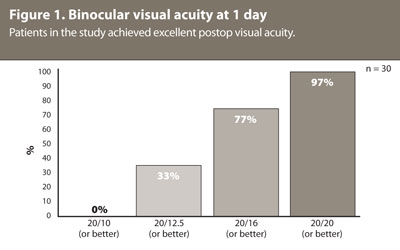
Source: Durrie DS
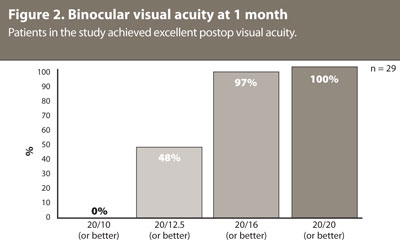
Source: Durrie DS
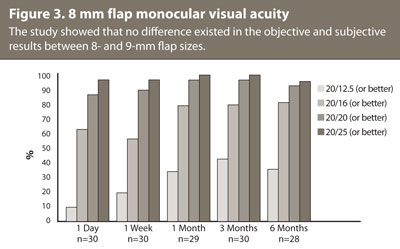
Source: Durrie DS
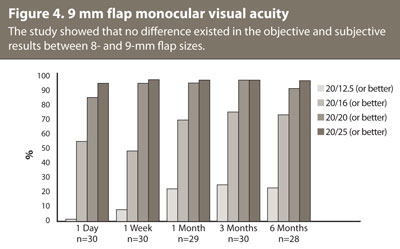
Source: Durrie DS
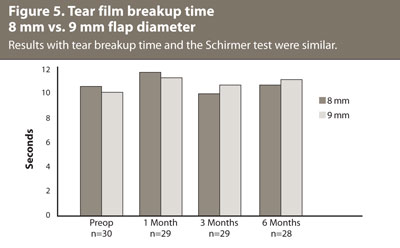
Source: Durrie DS

Source: Durrie DS
Results showed that patients experienced only temporary dry eye that in many cases improved beyond the preoperative baseline after healing. Some patients experienced mild temporary halos or glare at night associated with car headlights or illuminated signs, for example, which peaked at 1 month and then resolved by the 3-month visit. Others experienced mild glare with computer or TV use or at work. These symptoms also peaked at 1 month and resolved shortly thereafter. The onset and resolution of these halo and glare symptoms matched the onset and resolution of the temporary postoperative dryness, pointing to a possible causal relationship.
Conclusions, additional research
These findings highlight several interesting points in addition to our main outcome measures. First, the results show that thin-flap LASIK performed with modern lasers can produce excellent visual acuity results, irrespective of flap size. Second, the study demonstrated that LASIK does not cause dry eye in patients with no history of dry eye. Furthermore, subjective halos, glare and night vision problems were not worsened and in many cases improved after wavefront-guided laser vision correction. Further studies are needed to advance our knowledge in this area.
